Taking a look at CW element spacing with the latest firmware Yaesu comes to the QSK user's rescue with a quick fix to the problems identified on the Yahoo board and documented in the earlier report (below). In that prior firmware, the semi-breakin timing was close to ideal but the QSK was quite far off from the target of 3:1:1. Today we put the new firmware to the test. To see how close to 3:1:1 the timing is; and to check the consistency between semi-breakin and full QSK. Test setup - identical to before except for updated firmware as follows: - FT-DX5000MP - lot 21
- Firmware - control v119, EDSP v537
- DSO capture and measurement from RF emission - 200W
- 30 WPM
- 6 mS rise time menu setting
- 3.0 weighting menu setting
- Hantek DSO; measurements are accurate to 0.2 mS
Menu settings: 63 - BK-IN 64 - Shape 65 - Weight Internal Keyer ResultsThe test procedure is the same as with the prior test sequence. So I will give the screen captures below for reference and provide the results here. In each column set, the old firmware results are shown, then the new firmware results, and then a slightly improved WEIGHT setting (menu 65) of 1:3.1 (highlighted in yellow). As I measured the spacing, the weight between dot-dash was slightly light on the dash. Moving the weight to 3.1 provided nearly a perfect timing set. 3.2 weighting setting pushes the dah:dit ratio to about 3.06. Your choice - set and forget. Element/Item | Full | Full | Full | Semi | Semi | Semi | Firmware - CTL/EDSP | 118/533 | 119/537 | 119/537 | 118/533 | 119/537 | 119/537 | WEIGHT menu setting | 3.0 | 3.0 | 3.1 | 3.0 | 3.0 | 3.1 | DSO: Space Width | 48 | 41 | 40 | 40 | 40 | 41 | DSO: Dit Width | 36 | 43 | 43 | 43 | 43 | 43 | DSO: Dash Width | 115 | 121 | 127 | 121 | 123 | 127 | Dit:Space Ratio | 0.75 | 1.05 | 1.08 | 1.08 | 1.08 | 1.05 | Dah:Dit Ratio | 3.19 | 2.81 | 2.95 | 2.81 | 2.86 | 2.95 |
There are two important findings from this firmware: 1. The waveform is identical in both the QSK and SEMI modes. Which means whatever small adjustment to personal preference (e.g. weighting), the transmitted waveform will be the same in either mode. 2. The DOT:DASH:SPACE ratios are very close to ideal. The firmware provides for a slightly heavy weighting but well within acceptable limits. 3. By my measurements, the ability to hear between the elements is preserved. In fact, using the informal method based on the AF waveform height vs. speed, I measured a slightly improved ramp rate vs. the prior firmware versions. Full AF waveform height was possible in the new firmware up to almost 30 WPM vs. about 25 WPM in the prior version. External Keyer Results The external keying rig results are shown here. Rig is fed to the rear jack by the uHam MKII keyer. The output keying from the MKII is within 0.5 mS of ideal 3:1:1 as you can see in the graphic below: 
So the skew we see in the results is from the rig. The net effect is somewhat heavier weighting. Fortunately, the QSK and SEMI mode effects in this firmware version are the same - so adjusting the MKII is easy. The final MKII adjustments used are shown in the table (yellow). Element/Item | Full | Full | SemiW | MKII - WT | 50% | 45% | 50% | MKII - DOT:DASH | 300 | 302 | 300 | DSO: Space Width | 37 | 41 | 36 | DSO: Dit Width | 45 | 40 | 45 | DSO: Dash Width | 124 | 119 | 125 | Dit:Space Ratio | 1.22 | 0.98 | 1.25 | Dah:Dit Ratio | 2.76 | 2.98 | 2.78 |
In the default MKII configuration (50%, 300), the weighting sounds nice to my ear - but as I explain the earlier work (below), a heavier weighting is my preference. For users who are externally keying, they may prefer a slightly lighter weight and most advanced keyers provide this functionality. Given the consistent behavior of the rig with external keying, and the default toward a classic slightly heavier weighting, I don't consider this a significant shortcoming with the firmware. Conclusion - v119/537 FirmwareI think Yaesu has the right formula in this firmware version. Internal keyer timing is near perfect and consistent in mode. And the QSK recover time is as good or better than before. These is exactly what we were needing! External keying timing is a bit on the heavy side - but I believe many would consider this an "acceptable" performance level. Thanks Yaesu for making a great rig even better! And given finite firmware development resources, I would personally prefer Yaesu call the QSK concerns "addressed and solved" - and to now look into what I consider much bigger issues for the CW op - specifically the APF and the filter width functionality/ergonomics. DSO Captures of Pre/Post Firmware Update Screen shots below show a dot-dash repeating sequence. First the old firmware, followed by the same view with the new firmware. To gather the data presented in the table above a direct-measurement tool provided by the DSO allows for the exact value to be read from the capture. Semi - v118/533 firmware (below) 
Semi - v119/537 firmware (below) 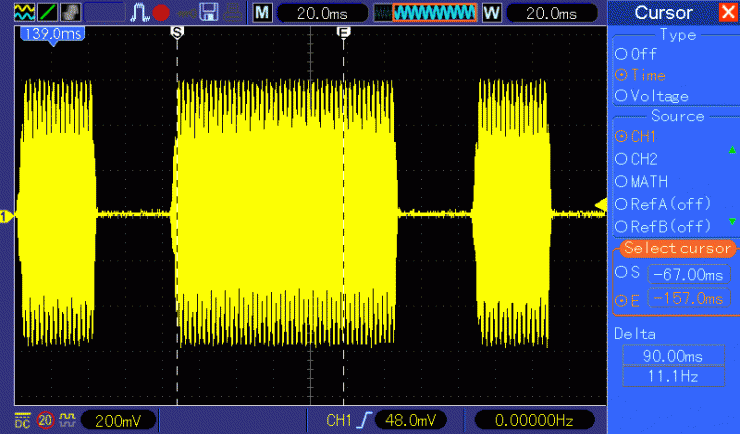
QSK - v118/533 firmware (below) 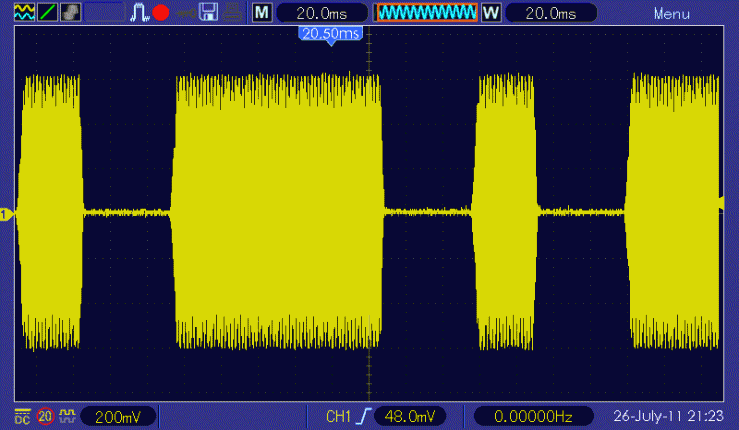
QSK - v119/537 firmware (below) 
!!!!!!!!!!!!!!!!!!!!!!!!!!!!!!!!!!!!!!!!!!!!!!!!!!!!!!!!!!!!!!!!!!!!!!!!!!!!! PRIOR FIRMWARE RESULTS !!!!!!!!!!!!!!!!!!!!!!!!!!!!!!!!!!!!!!!!!!!!!!!!!!!!!!!!!!!!!!!!!!!!!!!!!!!!! Test setup: - FT-DX5000MP - lot 21
- Firmware - control v118, EDSP v533
- DSO capture and measurement from RF emission - 200W
- 30 WPM
- 6 mS rise time menu setting
- 3.0 weighting menu setting
- Hantek DSO; measurements are accurate to 1 mS
Menu settings: 63 - BK-IN 64 - Shape 65 - Weight Internal Keyer Measurements Measurements were first made on the rig's full-break in ("QSK" BK-IN menu 63 setting). Screens and data looked like this: Full break-in, space measurement 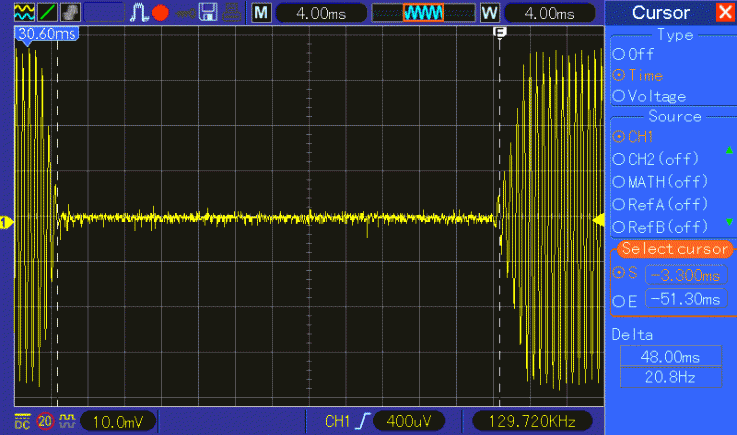
Full break-in, dit measurement 
Full break-in, dah measurement 
The dah:dit ratio is somewhat close to ideal 3:1, but the spacing of the elements is quite high by comparison. Adjusting the WEIGHT ratio (menu 65) to 2.8 provided a better dah:dit ratio (yellow cells, below) - but the element spacing remains too wide. Spacing of QSK break-in elements are long with respect to ideal spacing by about 35%. This is the fundamental problem with the current controller firmware. In SEMI break-in, the spacing is much closer to ideal with respect to element spacing. A slightly heavier dah:dit ratio of WEIGHT menu 65 setting 3.3 gives a much better overall result. Note that the Yaesu menu 65 is not a true "weight" in the classic tradition - but is more accurately a dit-dah ratio. The space and dit remain fixed; with the dah length changing with menu setting. Element | Full | Full | Semi | Semi | Key menu setting | 3.0 | 2.8 | 3.0 | 3.3 | Space Width | 48 | 48 | 40 | 41 | DSO: Dit Width | 35 | 35 | 43 | 43 | DSO: Dah Width | 115 | 106 | 122 | 126 | Dit:Space Ratio | 0.73 | 0.73 | 1.08 | 1.08 | Dah:Dit Ratio | 3.29 | 3.03 | 2.84 | 2.93 |
External Keyer Measurements Measurements using the rear panel external key input were taken next. Feeding the rig was a Microham MKII with the Winkey v10 chip. Manual keying as well as logger-driven keying of the rig via the MKII will provide the timing shown below. Adjustments in the MKII settings were made to optimize the element spacing (red cells). Optimum settings for standard 1:1:3 weighting are given in the table. The element timing is pretty different between QSK and SEMI settings such that it's not practical to keep the same settings and move between SEMI and QSK settings and hope to get near proper timing ratios. I prefer a bit heavier overall weighting and settings suitable for interested ops are included in the "Heavy" titled columns. Element | Full Std | Full Heavy | Semi Std | Semi Std | Semi Heavy | WK Dit/Dah Ratio | 306 | 320 | 306 | 307 | 335 | WK Weighting % | 54 | 60 | 54 | 47 | 54 | Space Width | 41 | 38 | 35 | 41 | 34 | DSO: Dit Width | 41 | 44 | 47 | 41 | 46 | DSO: Dah Width | 121 | 129 | 127 | 122 | 138 | Dit:Space Ratio | 1.00 | 1.16 | 1.34 | 1.00 | 1.35 | Dah:Dit Ratio | 2.95 | 2.93 | 2.70 | 2.98 | 3.00 |
Note that there is quite a bit of interaction between the two WK settings and the results as seen on the transmitted RF. 1st Dit Measurements Shown here a measurement of the first and second dits. 
Element | Int Full | Int Semi | Ext Full | Ext Semi | 1st Dit | 34.8 | 42.2 | 42.6 | 42.6 | 2nd Dit | 35.0 | 41.8 | 43.8 | 43.8 | 1st:2nd Ratio | 0.99 | 1.01 | 0.97 | 0.97 |
In the internal keyer case, there is no significant difference. In the external keyer case, only a minimal difference is noted (and is within the measurement error). Good job here Yaesu. Rise Time Measurements 4 mS setting gives roughly 2.5 mS actual rise time 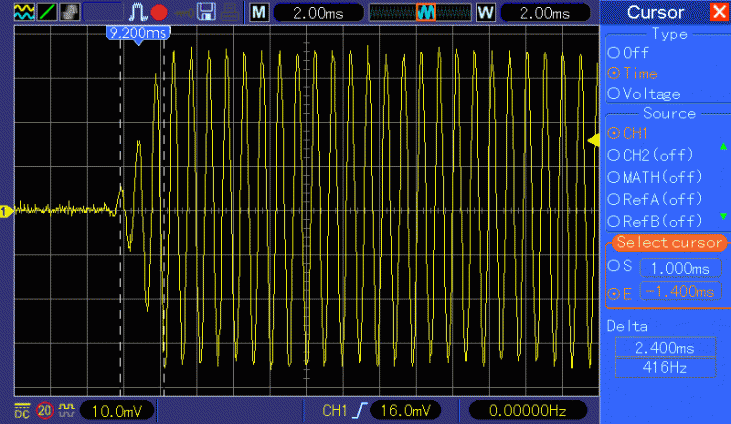
6 mS setting gives roughly 3.8 mS actual rise time 
Fall time is slightly less than 2 mS in both cases 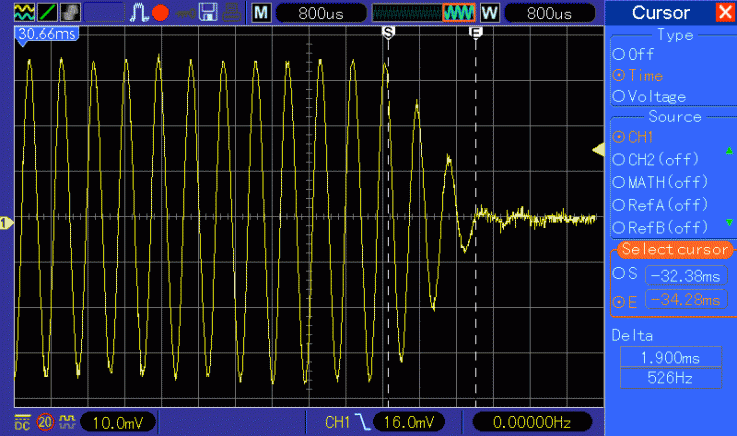
Rise times are specified at 10%-90% and were eye-ball interpolated here. The contribution to error by threshold differences is not significant. The rise and fall times (very short vs. menu setting) is similar to what I had measured with the 2K. These values have been independently verified by Sherwood in prior published work. Conclusions Actual rise time is about 2/3 of the menu setting The first element is not shortened significantly vs. subsequent elements SEMI break-in setting are reasonably close to 1:1:3 ideal spacing Spacing of QSK break-in elements are long with respect to ideal spacing by about 35% |